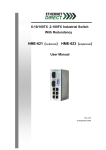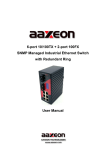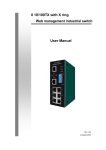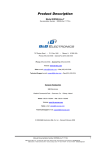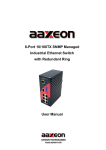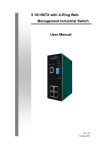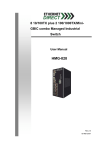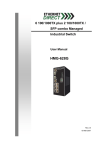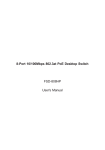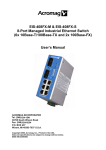Download Transition Networks SISTM10XX-162-LR User's Manual
Transcript
SISTM10xx-162-LR(T) (6) 10/100Base-TX + (2) 100Base-FX Industrial Managed Switch Installation Manual Rev. 1 25-October-2007 Notice This manual contents are based on the below table listing software kernel version, hardware version, and firmware version. If the switch functions have any different from the manual contents description, please contact Transition Networks for more information. Firmware Version v1.02 Kernel Version v3.22 Hardware Version A5.00 FCC Warning This Equipment has been tested and found to comply with the limits for a Class-A digital device, pursuant to Part 15 of the FCC rules. These limits are designed to provide reasonable protection against harmful interference in a residential installation. This equipment generates uses and can radiate radio frequency energy and, if not installed and used in accordance with the instructions, may cause harmful interference to radio communications. However, there is no guarantee that interference will not occur in a particular installation. If this equipment does cause harmful interference to radio or television reception, which can be determined by turning the equipment off and on, the user is encouraged to try to correct the interference by one or more of the following measures: • Reorient or relocate the receiving antenna. • Increase the separation between the equipment and receiver. • Connect the equipment into an outlet on a circuit different from that to which the receiver is connected. • Consult the dealer or an experienced radio/TV technician for help. CE Mark Warning This is a Class-A product. In a domestic environment this product may cause radio interference in which case the user may be required to take adequate measures. Contents Notice........................................................................................................................................... 1 FCC Warning ............................................................................................................................... 1 CE Mark Warning ........................................................................................................................ 1 Introduction ................................................................................................................................... 1 Features....................................................................................................................................... 1 Package Contents ....................................................................................................................... 2 Hardware Description ................................................................................................................... 3 Physical Dimension...................................................................................................................... 3 Front Panel .................................................................................................................................. 3 Reset Button .......................................................................................................................... 3 Bottom View................................................................................................................................. 4 DIP-switch.................................................................................................................................... 4 LED Indicators ............................................................................................................................. 5 Ports ............................................................................................................................................ 6 Cabling......................................................................................................................................... 8 Wiring the Power Inputs............................................................................................................... 8 Wiring the Fault Alarm Contact .................................................................................................... 8 Wiring the Fault Alarm Contact .................................................................................................... 9 Mounting Installation .................................................................................................................. 10 DIN-Rail Mounting ..................................................................................................................... 10 Wall Mount Plate Mounting ........................................................................................................ 11 Hardware Installation .................................................................................................................. 11 Hardware Installation .................................................................................................................. 12 Installation Steps ....................................................................................................................... 12 Network Application.................................................................................................................... 13 X-Ring Application ..................................................................................................................... 14 Coupling Ring Application.......................................................................................................... 15 Dual Homing Application............................................................................................................ 15 Web-Based Management ............................................................................................................ 16 About Web-based Management ................................................................................................ 16 Preparing for Web Management ................................................................................................ 16 System Login ............................................................................................................................. 16 Port status.................................................................................................................................. 17 Single Port Information ........................................................................................................ 18 Port Statistics............................................................................................................................. 18 Port Control................................................................................................................................ 19 Switch Setting ............................................................................................................................ 19 Port Mirroring ............................................................................................................................. 20 VLAN configuration .................................................................................................................... 21 Port-based VLAN ................................................................................................................. 22 802.1Q VLAN....................................................................................................................... 23 802.1Q VLAN....................................................................................................................... 24 Alert ........................................................................................................................................... 27 Email Alert Configuration ..................................................................................................... 27 Event Configuration ............................................................................................................. 28 Power Alarm Configuration .................................................................................................. 29 IP Configuration ......................................................................................................................... 29 SNTP Configuration ................................................................................................................... 30 IP Security ................................................................................................................................. 32 RSTP Configuration ................................................................................................................... 32 System Configuration........................................................................................................... 33 Per Port Configuration ......................................................................................................... 34 X-Ring........................................................................................................................................ 35 QoS Configuration ..................................................................................................................... 37 IGMP.......................................................................................................................................... 38 Security Manager....................................................................................................................... 39 SNMP Configuration .................................................................................................................. 40 System Options.................................................................................................................... 41 Community strings ............................................................................................................... 41 Trap Manager ...................................................................................................................... 41 Configuration Backup................................................................................................................. 41 TFTP Restore Configuration ................................................................................................ 41 TFTP Backup Configuration................................................................................................. 42 TFTP Update Firmware ............................................................................................................. 42 Factory Default .......................................................................................................................... 43 System Reboot .......................................................................................................................... 43 Save Configuration .................................................................................................................... 44 Rate Control............................................................................................................................... 44 System Log................................................................................................................................ 45 System Log Configuration.................................................................................................... 45 Event Configuration ............................................................................................................. 46 Troubles shooting ....................................................................................................................... 48 Technical Specification............................................................................................................... 49 Introduction The SISTM10xx-162-LRx Managed Industrial Switch is a cost-effective solution and meets the high reliability requirements demanded by industrial applications. The switch can be easily managed through the Web GUI. By using fiber port can extend the connection distance that increases the network elasticity and performance. It also provides the X-Ring function that can prevent the network connection failure. Features • Conform to IEEE 802.3 10Base-T, 802.3u 100Base-TX/100Base-FX • 6-port 10/100TX plus 2 100FX port industrial switch • RJ-45 port support auto MDI/MDI-X function • Store-and-Forward switching architecture • Wide-range redundant power design • DIN rail and wall mount design • 2K MAC address table • Web management GUI • Per port supports 4 priority queues • Provides Fiber link ability • IEEE 802.3x flow control support o Flow control with full-duplex o Back pressure with half-duplex • Support Class of service • Support IGMP with Query mode for multi media application • Supports ingress packet filter and egress rate limit. • Support SNTP/SMTP • Port mirror for TX or TX and RX packet. • Alarm Relay output for system events • Support X-Ring function • Power polarity reverse protect • 1Mbits Embedded memory • Support Port based VLAN / 802.1 Q Tag VLAN • IEEE 802.1p class of service and provide port base, Tag base and Type of service priority method • Support DHCP client • SNMP, Web Management, RMON supported • TFTP firmware update and system configure restore and backup 1 Package Contents Please refer to the package content list below to verify them against the checklist. • SISTM10xx-162-LRx Managed Industrial Switch • DC Jack 2.0/150mm RoHS • User manual CD • DIN-Rail Bracket (attached on the switch) • One wall mount plate and six screws SISTM10xx-162-LRx Wall Mount Plate DC Jack 2.0/150mm RoHS Screws User Manual CD DIN-Rail Bracket (installed) Compare the contents of the industrial switch with the standard checklist above. If any item is damaged or missing, please contact Transition Networks. 2 Hardware Description In this paragraph, it will describe the Industrial switch’s hardware spec, port, cabling information, and wiring installation. Physical Dimension 54mm (w) x 135mm (h) x 105mm (d) Front Panel The Front Panel of the SISTM10xx-162-LRx Managed Industrial Switch is shown below: Reset Button The reset button provides user a quick and easy way to restart and set the configuration back to default value. • Restart: press the button for 2 seconds and release • Set to factory default value: press the button for 5 seconds and release. The switch will 3 set all configurations back to default setting Bottom View The bottom view of the switch is shown below: Grounding Screw 6-position terminal block Primary power input terminals (2) Secondary power input Contact relay output terminals (2) DIP-switch The switch provides the 9 DIP-switch for configuring the relay alarm operation mode and the master ring operation mode. The default value of Dipswitch is OFF. DIP Switch No Status OFF 1 ON OFF 2 ON OFF 3 ON OFF 4 ON Description Disable port 1 Alarm Enable port Alarm. If the port’s link fails, the fault LED will light up Disable port Alarm Enable port Alarm. If the port’s link fails, the fault LED will light up Disable port Alarm Enable port Alarm. If the port’s link fails, the fault LED will light up Disable port Alarm Enable port Alarm. If the port’s link fails, the fault LED will light up 4 OFF Disable port Alarm 5 Enable port Alarm. If the port’s link fails, the fault ON LED will light up OFF 6 Disable port Alarm Enable port Alarm. If the port’s link fails, the fault ON LED will light up OFF 7 Disable port Alarm Enable port Alarm. If the port’s link fails, the fault ON LED will light up OFF 8 Disable port Alarm Enable port Alarm. If the port’s link fails, the fault ON LED will light up OFF 9 Disable the ring master function Enable the switch as the ring master in the X-Ring ON group [NOTE] 1. When port alarm function is enabled, the fault LED will on and Alarm relay will activity when port failure occurs. 2. Please restart the switch after the X-Ring DIP switch is set. LED Indicators There are 7 diagnostic LEDs located on the front panel of the industrial switch. They provide realtime information of system and optional status. The following table provides description of the LED status and their meanings for the switch. LED Status Meaning Green The switch unit is power on Off The switch unit is no power input Green Power on Off No power inputs Green Power on Power Power 1 Power 2 5 Off Yellow No power inputs Power failure or UTP port failure or Fiber port failure Fault Off Green No Power failure or UTP port failure or Fiber port failure occurs The industrial switch is the master of X-Ring group R.M. (Ring Master) Off Green LNK/ACT Blinks (Fiber port) FDX/COL The industrial switch is not a ring master in XRing group The port is linking The port is transmitting or receiving packets from the TX device Off No device attached Yellow The port is operating in full-duplex mode Blinks Collision of Packets occurs in the port (Fiber Port) Off The port in half-duplex mode or no device attached Ports RJ-45 ports There are 6x 10/100Mbps auto-sensing ports for 10Base-T or 100Base-TX devices connection. The UTP ports will auto-sense for 10Base-T or 100Base-TX connections. Auto MDI/MDIX means that the switch can connect to another switch or workstation without changing straight through or crossover cabling. See the below figures for straight through and crossover cable schematic. RJ-45 Pin Assignments [NOTE] Pin Number Assignment 1 Tx+ 2 Tx- 3 Rx+ 6 Rx- “+” and “-” signs represent the polarity of the wires that make up each wire pair. 6 All ports on this industrial switch support automatic MDI/MDI-X operation, user can use straightthrough cables (See figure below) for all network connections to PCs or servers, or to other switches or hubs. In straight-through cable, pins 1, 2, 3, and 6, at one end of the cable, are connected straight through to pins 1, 2, 3 and 6 at the other end of the cable. The table below shows the 10BASET/100BASE-TX MDI and MDI-X port pin outs. Pin MDI-X Signal Name MDI Signal Name 1 Receive Data plus (RD+) Transmit Data plus (TD+) 2 Receive Data minus (RD-) Transmit Data minus (TD-) 3 Transmit Data plus (TD+) Receive Data plus (RD+) 6 Transmit Data minus (TD-) Receive Data minus (RD-) Straight Through Cable Schematic Cross Over Cable Schematic Fiber Port There are two 100Base-FX ports. The fiber port is ST type connector in multi mode (2Km) or single mode (30Km). 7 ATTENTION This is a Class 1 Laser/LED product. Don’t stare into the Laser/LED Beam. Cabling • Using four twisted-pair, Category 5 cabling for RJ-45 port connection. The cable between the converter and the link partner (switch, hub, workstation, etc.) must be less than 100 meters (328 ft.) long. • Fiber segment using single-mode connector type must use 9/125 um single-mode fiber cable. • Fiber segment using multi-mode connector type must use 50 or 62.5/125 um multi-mode fiber User can connect two devices in the distance up to 30 Kilometers. cable. User can connect two devices up to 2Km distances. Wiring the Power Inputs Please follow below steps to insert the power wire. V- V+ 1. V- V+ Insert the positive and negative wires into the V+ and V- connector on the terminal block connector. 2. To tighten the wire-clamp screws for preventing the DC wires to loose. [NOTE] The wire range of terminal block is from 12~ 24 AWG. 8 Wiring the Fault Alarm Contact The fault alarm contact is in the middle of terminal block connector as below figure shows. By inserting the wires and set the DIP switch at “ON” status, it will detect the fault status which the power is failure or port link failure and form an open circuit. And, application example for the fault alarm contact as below: 1A@24V Insert the wires into the fault alarm contact [NOTE] The wire range of terminal block is from 12~ 24 AWG. Fault Alarm Contact The open circuit will form when the power failure or port link failure. 24V DC Buzzer 24V Battery The fault alarm device will send a warning signal to warn the user, ex: alarm sound or flash light. 9 Mounting Installation DIN-Rail Mounting The DIN-Rail is screwed on the industrial switch when out of factory. 1. First, insert the top of DIN-Rail into the track. 2. Then, lightly push the DIN-Rail into the track. 10 3. Check the DIN-Rail is tightly on the track. 4. To remove the industrial switch from the track, reverse steps above. Wall Mount Plate Mounting Follow the below steps to mount the industrial switch with wall mount plate. 1. Remove the DIN-Rail from the industrial switch; loose the screws to remove the DIN-Rail. 2. Place the wall mount plate on the rear panel of the industrial switch. 3. Use the screws to screw the wall mount plate on the industrial switch. 4. Use the hook holes at the corners of the wall mount plate to hang the industrial switch on the wall. 5. To remove the wall mount plate, reverse steps above. Screwing the wall mount plate on the Industrial media converter 11 Hardware Installation Installation Steps 1. Unpacking the Industrial switch 2. Check the DIN-Rail is screwed on the Industrial switch. If the DIN-Rail is not screwed on the Industrial switch. Please refer to DIN-Rail Mounting section for DIN-Rail installation. If user want to wall mount the Industrial switch, then please refer to Wall Mount Plate Mounting section for wall mount plate installation. 3. To hang the Industrial switch on the DIN-Rail track or wall, please refer to the Mounting Installation section. 4. Power on the Industrial switch. How to wire the power; please refer to the Wiring the Power Inputs section. The power LED on the Industrial switch will light up. Please refer to the LED Indicators section for meaning of LED lights. 5. Prepare the twisted-pair, straight through Category 5 cable for Ethernet connection. 6. Insert one side of RJ-45 cable (category 5) into the Industrial switch Ethernet port (RJ-45 port) and another side of RJ-45 cable (category 5) to the network devices’ Ethernet port (RJ-45 port), ex: Switch PC or Server. The UTP port (RJ-45) LED on the Industrial switch will light up when the cable connected with the network device. Please refer to the LED Indicators section for LED light meaning. [NOTE] Be sure the connected network devices support MDI/MDI-X. If it does not support then use the crossover category-5 cable. 7. When all connections are all set and LED lights all show in normal, the installation is complete. 12 Network Application This chapter provides some sample applications to help user to have more actual idea of industrial switch function application. A sample application of the industrial switch is as below: 13 X-Ring Application The industrial switch supports the X-Ring protocol that can help the network system to recovery from network connection failure within 300ms or less, and make the network system more reliable. The XRing algorithm is like as spanning tree protocol (STP) algorithm but it has faster recovery time than STP. The following figure is a sample X-Ring application. 14 Coupling Ring Application In the network, it may have more than one X-Ring group. By using the coupling ring function can connect each X-Ring for the redundant backup. It can ensure the transmissions between two ring groups will no failure. The following figure is a sample of coupling ring application. Dual Homing Application Dual Homing function is to prevent a lost connection between X-Ring group and upper level/core switch. Assign two ports to be the Dual Homing port that is backup port in the X-Ring group. The Dual Homing function only works when the X-Ring function is active. Each X-Ring group only has one Dual Homing port. [NOTE] In Dual Homing application architecture, the upper level switches need to enable the Rapid Spanning Tree protocol. 15 Web-Based Management About Web-based Management On CPU board of the switch there is an embedded HTML web site residing in flash memory, which offers advanced management features and allow users to manage the switch from anywhere on the network through a standard browser such as Microsoft Internet Explorer. The Web-Based Management supports Internet Explorer 6.0. And, it is applied for Java Applets for reducing network bandwidth consumption, enhance access speed and present an easy viewing screen. Preparing for Web Management Before to use web management, install the industrial switch on the network and make sure that any one of PC on the network can connect with the industrial switch through the web browser. The industrial switch default value of IP, subnet mask, username and password is as below: • IP Address: 192.168.16.1 • Subnet Mask: 255.255.255.0 • Default Gateway: 192.168.16.254 • User Name: root • Password: root System Login 1. Launch the Internet Explorer on the PC 2. Key in “http:// “+” the IP address of the switch”, and then Press “Enter”. 3. The login screen will appear right after 4. Key in the user name and password. The default user name and password as “root” 5. Press “Enter” or ”OK”, and then the home screen of the Web-based management appears as below: 16 Function Menu Bar Home Interface Panel Figure Display Configuration Display Screen Port status View every port status that depended on user’s setting and the negotiation result • Port: The port number • Type: The speed mode, ex: 100TX = 100Mbps • Link: “Down” means “No Link”. “UP” is for “Link” • State: Display port statuses “disable” or “enable”. “Unlink” will be treated as “off” • Negotiation: Display the auto negotiation mode: auto/force. “Config” means the value that user configured. “Actual” means the current value of the port • Speed Duplex: Display port connection speed. “Config” means the value that user configured. “Actual” means the current value of the port • Flow Control: Display the flow control status is “enable” or “disable” in full mode. “Config” means the value that user configured. “Actual” is for the current value of the port Port Status interface 17 Single Port Information Click the port on the Panel figure on the web interface directly. Then, the single port information window will show up and display the port current information. Port information interface Port Statistics The following information provides the current port statistic information Click Clear button to clean all counts Port Statistics Interface 18 Port Control Change the port status • Select the port by scroll the Port column • State: Disable or enable control of this port • Negotiation: Set auto negotiation mode is Auto, Nway (specify the speed/duplex on this port and enable auto-negotiation), or Force • Speed: Set the speed of the port • Duplex: Set full-duplex or half-duplex mode of the port • Flow control: Set flow control function is Symmetric or Asymmetric in Full Duplex mode. The default value is Disable Apply • And then, click button to apply all configuration • When user select the port, user can see port current configure shows in below column Port Control interface Switch Setting Assigning the system name, location and view the system information • System Name: Assign the name of switch. The maximum length is 64 bytes • System Description: Display the description of switch. Read only cannot be modified • System Location: Assign the switch physical location. The maximum length is 64 bytes • System Contact: Enter the name of contact person or organization • Firmware Version: Display the switch’s firmware version • Kernel Version: Display the kernel software version 19 • Hardware version: Display the switch hardware version • MAC Address: Display the unique hardware address assigned by manufacturer (default) Switch settings interface [NOTE] Remember to execute the “Save Configuration” action, otherwise the new configuration will lose when switch power off. Port Mirroring The Port mirroring is a method for monitor traffic in switched networks. Traffic through ports can be monitored by one specific port. That is, traffic goes in or out monitored ports will be duplicated into mirror port. • Port Mirroring Mode: Set mirror mode -- Disable, TX, and Both. The default value is “Disable” • Analysis Port: It means mirror port can be used to see all monitor port traffic. User can connect mirror port to LAN analyzer or Netxray • Monitor Port: The ports user wants to monitor. All monitor port traffic will be copied to mirror port. User can select max 7 monitor ports in the switch. User can choose which port that wants to monitor in only one mirror mode. Mark the State check box to select the port • And then, click Apply 20 Port Mirroring interface [NOTE] 1. Select the monitor mode as disable to disable the mirroring 2. Remember to execute the “Save Configuration” action, otherwise the new configuration will lose when switch power off. VLAN configuration A Virtual LAN (VLAN) is a logical network grouping that limits the broadcast domain, which would, allow you to isolate network traffic so only the members of the VLAN will receive traffic from the same members of VLAN. Basically, creating a VLAN from a switch is logically equivalent of reconnecting a group of network devices to another Layer 2 switch. However, all the network devices are still plugged into the same switch physically. The industrial switch supports port-based and 802.1Q (tagged-based) VLAN. In the default configuration, VLAN operation mode default is “Disable”. 21 VLAN Configuration interface Port-based VLAN Packets can go among only members of the same VLAN group. Note all unselected ports are treated as belonging to another single VLAN. If the port-based VLAN enabled, the VLAN-tagging is ignored. In order for an end station to send packets to different VLAN groups, it itself has to be either capable of tagging packets it sends with VLAN tags or attached to a VLAN-aware bridge that is capable of classifying and tagging the packet with different VLAN ID based on not only default PVID but also other information about the packet, such as the protocol. VLAN – PortBase interface 22 • Click Add to add a new VLAN group(The maximum VLAN group is up to 64 VLAN groups) • Entering the VLAN name, group ID and grouping the members of VLAN group • And then, click Apply VLAN—PortBase Add interface • The VLAN group will list • To view the another VLAN groups, click • To delete unwanted VLAN, click • To modify existing VLAN group, press Next Page Delete button Edit button [NOTE] Remember to execute the “Save Configuration” action, otherwise the new configuration will lose when switch power off. 23 802.1Q VLAN Tagged-based VLAN is an IEEE 802.1Q specification standard which it allows to create a VLAN across devices from different switch venders. IEEE 802.1Q VLAN uses a technique to insert a “tag” into the Ethernet frames. Tag contains a VLAN Identifier (VID) that indicates the VLAN numbers. All ports on the switch belong to default VLAN, VID is 1. The default VLAN can’t be deleting. The maximum VLAN group is up to 64 VLAN groups. 802.1q VLAN interface Basic VLAN • Click Add • Management VLAN ID: It is used for Remote Management Security. In fact, it can button remote management that includes telnet, SNMP, and Web browse the switch, only when the port of VLAN group ID is equal to the Management VLAN ID. Fill the specific VLAN ID number in Management VLAN ID column and mark the check box, and then click Apply button to enable the function. For example: the management VLAN ID is 101, the VLAN group ID 101 includes the port 1, 2, and 4. Therefore, only port 1, 2, and 4 can remote management the switch. And, if the port is in two different VLAN groups and one of VLAN group ID is equal to the assigned Management VLAN ID, it still has the right to remote management the switch. • Group Name: Assign a name for the new VLAN • VLAN ID: Key in a VLAN ID (2~4094). The default is 1 24 • Grouping the ports and click Add button 802.1q VLAN –Add interface • And then, click Next then follow interface as below. 25 Apply Click to set the outgoing frames are VLAN-Tagged frames or untagged Tag: Outgoing frames with VLAN-Tagged Untag: Outgoing frames without VLAN-Tagged Port VLAN ID • Configure port VID settings • Port VLAN ID: Enter the port VLAN ID • And then, click Apply • To reset back to default value, click Default button 802.1q VLAN – Port VLAN ID interface [NOTE] Remember to execute the “Save Configuration” action, otherwise the new configuration will lose when switch power off. 26 Alert There are three kinds of alert – e-mail, event, and power alarm for user to configure. Email Alert Configuration When the specific events occur, the system will send the alert to the email account that is assigned by user. User can set up the mail server IP, mail account, and forwarded email account for receiving the event alert. Email Alert: To enable or disable the email alert function SMTP Server IP Address: Set up the mail server IP address Authentication: Mark the check box to enable and configure the email account and password for authentication Mail Account: Set up the email account to receive the alert. Ex: [email protected]. The email account must exist on the mail server, which user had set up in SMTP Server IP Address column Password: The email account password Confirm Password: Re-confirm the password E-mail Address of Receipient 1 ~ 4: Assign up to 4 e-mail accounts also to receive the alert And then, click Apply Email Alert Configuration interface 27 Event Configuration The selected events that occur will send out the alert to the assigned SMTP server. Also, user can select port events for alerting. • System event selection: 4 selections – Device cold start, Power status, SNMP Authentication Failure, and X-Ring topology changes. Mark the checkbox to select the event. When selected events occur, the system will sent out the alerting Device cold start: When the device executes cold start action, the system will send out the alert to the dedicate SMTP server Power status: When the device power status has changed, the system will send out the alert to the dedicate SMTP server SMNP Authentication Failure: When the SNMP authentication fail, the system will send out the alert to the dedicate SMTP server X-Ring topology change: When the X-Ring topology has changed, the system will send out the alert to dedicate SMTP server • Port event selection: Select the per port events. Per port has 3 selections – Link UP, Link Down, and Link UP & Link Down. Disable means no event is selected Link UP: The system will send out an alert when port connection is up only Link Down: The system will send out an alert message when port connection is down only Link UP & Link Down: The system will send out an alert message when port connection is up and down • After selected, click Apply Event Configuration interface 28 Power Alarm Configuration Power alarm function enables the Relay alarm action. Without enabling power alarm function, the Relay alarm action will not work even the Relay alarm is set. • Mark the check box and click Apply button Power Alarm interface IP Configuration User can configure the IP Settings and DHCP client function • DHCP Client: To enable or disable the DHCP client function. When DHCP client function is enabling, the industrial switch will be assigned the IP address from the network DHCP server. The default IP address will be replace by the DHCP server assigned IP address. After user click “Apply” button, a popup dialog show up. It is to inform the user that when the DHCP client is enabling, the current IP will lose and user should find the new IP on the DHCP server. To cancel the enabling DHCP client function, click “cancel” • IP Address: Assign the IP address that the network is using. If DHCP client function is enabling, and then user don’t need to assign the IP address. And, the network DHCP server will assign the IP address for the industrial switch and display in this column. The default IP is 192.168.16.1 • Subnet Mask: Assign the subnet mask of the IP address. If DHCP client function is enabling, and then user do not need to assign the subnet mask • Gateway: Assign the network gateway for the industrial switch. The default gateway is 192.168.16.254 • And then, click Apply button 29 IP configuration interface SNTP Configuration User can configure the SNTP (Simple Network Time Protocol) settings. The SNTP allows user to synchronize switch clocks in the Internet. • • SNTP Client: To enable or disable SNTP function to get the time from the SNTP server Daylight Saving Time: To enable or disable daylight saving time function. When daylight saving time is enabling, user need to configure the daylight saving time period • UTC Timezone: Set the switch location time zone. The following table lists the different location time zone for the reference. User also can drag down the list to find the time zone user want it. Local Time Zone Conversion from UTC Time at 12:00 UTC November Time Zone - 1 hour 11am Oscar Time Zone -2 hours 10 am ADT - Atlantic Daylight -3 hours 9 am -4 hours 8 am -5 hours 7 am -6 hours 6 am -7 hours 5 am -8 hours 4 am ALA - Alaskan Standard -9 hours 3 am HAW - Hawaiian Standard -10 hours 2 am Nome, Alaska -11 hours 1 am +1 hour 1 pm AST - Atlantic Standard EDT - Eastern Daylight EST - Eastern Standard CDT - Central Daylight CST - Central Standard MDT - Mountain Daylight MST - Mountain Standard PDT - Pacific Daylight PST - Pacific Standard ADT - Alaskan Daylight CET - Central European FWT - French Winter MET - Middle European 30 MEWT - Middle European Winter SWT - Swedish Winter EET - Eastern European, USSR Zone 1 +2 hours 2 pm BT - Baghdad, USSR Zone 2 +3 hours 3 pm ZP4 - USSR Zone 3 +4 hours 4 pm ZP5 - USSR Zone 4 +5 hours 5 pm ZP6 - USSR Zone 5 +6 hours 6 pm WAST - West Australian Standard +7 hours 7 pm CCT - China Coast, USSR Zone 7 +8 hours 8 pm JST - Japan Standard, USSR Zone 8 +9 hours 9 pm +10 hours 10 pm +12 hours Midnight EAST - East Australian Standard GST Guam Standard, USSR Zone 9 IDLE - International Date Line NZST - New Zealand Standard NZT - New Zealand • SNTP Sever IP: Set the SNTP server IP address • Switch Timer: Display the switch current time • Daylight Saving Period: Set up the Daylight Saving beginning and ending time. Daylight • Daylight Saving Offset (mins): Configure the offset value • And then, click Saving beginning and ending time will be different in every year Apply button [NOTE] Remember to execute the “Save Configuration” action, otherwise the new configuration will lose when switch power off. SNTP Configuration 31 IP Security IP security function allows user to assign 10 specific IP addresses that have permission to access the switch through the web browser for the securing switch management. • • Enable the IP Security: Mark the check box to enable the IP security function Security IP 1 ~ 10: Assign up to 10 specific IP address. Only these 10 IP address can access and manage the switch through the Web browser • And then, click Apply button to apply the configuration [NOTE] Remember to execute the “Save Configuration” action, otherwise the new configuration will lose when switch power off. IP Security Interface RSTP Configuration The Rapid Spanning Tree Protocol (RSTP) is an evolution of the Spanning Tree Protocol and provides for faster spanning tree convergence after a topology change. The system also supports STP and the system will auto detect the connected device that is running STP or RSTP protocol. 32 System Configuration • User can view spanning tree information about the Root Bridge • User can modify RSTP state. After modification, click Apply button RSTP mode: user must enable or disable RSTP function before configure the related parameters Priority (0-61440): a value used to identify the root bridge. The bridge with the lowest value has the highest priority and is selected as the root. If the value changes, user must reboot the switch. The value must be multiple of 4096 according to the protocol standard rule Max Age (6-40): the number of seconds a bridge waits without receiving Spanning-tree Protocol configuration messages before attempting a reconfiguration. Enter a value between 6 through 40 Hello Time (1-10): the time that controls switch sends out the BPDU packet to check RSTP current status. Enter a value between 1 through 10 Forward Delay Time (4-30): the number of seconds a port waits before changing from its Rapid Spanning-Tree Protocol learning and listening states to the forwarding state. Enter a value between 4 through 30 [NOTE] 1. Must follow the rule to configure the MAX Age, Hello Time, and Forward Delay Time 2 x (Forward Delay Time value –1) > = Max Age value >= 2 x (Hello Time value +1) 2. Remember to execute the “Save Configuration” action, otherwise the new configuration will lose when switch power off 33 RSTP– System Configuration Interface Per Port Configuration Configure path cost and priority of every port • Select the port in Port column • Path Cost: The cost of the path to the other bridge from this transmitting bridge at the specified port. Enter a number 1 through 200000000 • Priority: Decide which port should be blocked by priority in LAN. Enter a number 0 through 240. The value of priority must be the multiple of 16 • Admin P2P: Some of the rapid state transactions that are possible within RSTP are dependent upon whether the port concerned can only be connected to exactly one other bridge (i.e. it is served by a point-to-point LAN segment), or can be connected to two or more bridges (i.e. it is served by a shared medium LAN segment). This function allows the P2P status of the link to be manipulated administratively. True is P2P enabling. False is P2P disabling • Admin Edge: The port directly connected to end stations cannot create bridging loop in the network. To configure the port as an edge port, set the port to “True” status • Admin Non Stp: The port includes the STP mathematic calculation. True is not including STP mathematic calculation. False is including the STP mathematic calculation • And then, click Apply button [NOTE] Remember to execute the “Save Configuration” action, otherwise the new configuration will lose when switch power off. 34 RSTP – Per Port Configuration interface X-Ring X-Ring provides a faster redundant recovery than Spanning Tree topology. The action is similar with STP or RSTP, but the algorithms not the same. In the X-Ring topology, every switch should enable X-Ring function and assign two member ports in the ring. Only one switch in the X-Ring group would be set as a backup switch that one of two member ports would be blocking, called backup port, and another port is called working port. Other switches are called working switches and their two member ports are called working ports. When the network connection failure, the backup port will automatically become a working port to recovery the failure. The switch supports one Dipswitch for setting the switch as the ring master or slave mode. The ring master has the rights to negotiate and place command to other switches in the X-Ring group. If there are 2 or more switches are in master mode, then software will select the switch with lowest MAC address number as the ring master. The X-Ring master ring mode will be enabling by the DIP Switch. When the switch is set to the master ring mode, the X-Ring configuration interface will display the switch as the master ring message. Also, user can identify the switch as the ring master from the R.M. LED panel of the LED panel on the switch. 35 The system also supports the coupling ring that can connect 2 or more X-Ring group for the redundant backup function and dual homing function that prevent connection lose between X-Ring group and upper level/core switch. • Enable X-Ring: To enable the X-Ring function. Marking the check box to enable the X-Ring function. • st nd 1 &2 Working Ports: Assign two ports as the member ports. One port will be working port and one port will be the backup port. The system will automatically decide which port is working port and which port is backup port. • Enable Coupling Ring: To enable the coupling ring function. Marking the check box to enable the coupling ring function. • Coupling port: Assign the member port. • Control port: Set the switch as the master switch in the coupling ring. • Enable Dual Homing: Set up one of port on the switch to be the Dual Homing port. In an X-Ring group, maximum Dual Homing port is one. Dual Homing only work when the X-Ring function enable. • And then, click Apply to apply the configuration. X-Ring Interface [NOTE] 1. When the X-Ring function enable, user must disable the RSTP. The X-Ring function and RSTP function cannot exist at the same time. 2. Remember to execute the “Save Configuration” action, otherwise the new configuration will lose when switch power off. 36 QoS Configuration Configure Qos setting of the every port • Oos Policy: Select the Qos policy rule Using the 8,4,2,1 weight fair queue scheme: The switch will follow 8:4:2:1 rate to process priority queue from Hi to lowest queue. For example: the system will process 8 high queue packets, 4 middle queue packets, 2 low queue packets, and the one lowest queue packets at the same time Use the strict priority scheme: The higher queue will always be process first, except higher queue is empty • Priority Type: Every port has 5 priority type selections Port-base: The port priority will follow the default port priority that user have assigned – High, middle, low, or lowest COS only: The port priority will only follow the COS priority that user have assigned TOS only: The port priority will only follow the TOS priority that user have assigned COS first: The port priority will follow the COS priority first, and then other priority rule TOS first: The port priority will follow the TOS priority first, and the other priority rule • COS priority: Set the COS priority level 0~7 • TOS priority: The system provides 0~63 TOS priority level. Each level has 4 types of priority – high, mid, low, and lowest. The default value is “Lowest” priority for each level. When the IP packet is received, the system will check the TOS level value in the IP packet has received. For example: user set the TOS level 25 is high. The port 1 is following the TOS priority policy only. When the packet received by port 1, the system will check the TOS value of the received IP packet. If the TOS value of received IP packet is 25(priority = high), and then the packet priority will have highest priority. [NOTE] QoS and Rate control cannot be existed at the same time. 37 QoS configuration Interface IGMP The Internet Group Management Protocol (IGMP) is an internal protocol of the Internet Protocol (IP) suite. IP manages multicast traffic by using switches, routers, and hosts that support IGMP. Enabling IGMP allows the ports to detect IGMP queries and report packets and manage IP multicast traffic through the switch. IGMP have three fundamental types of message as follows: 38 Message Description A message sent from the querier (IGMP router or switch) asking Query for a response from each host belonging to the multicast group. A message sent by a host to the querier to indicate that the host Report wants to be or is a member of a given group indicated in the report message. A message sent by a host to the querier to indicate that the host Leave Group has quit to be a member of a specific multicast group. User can enable IGMP protocol and IGMP Query function in here. User will see the IGMP snooping information in this section -- difference multicast group VID and member port, and IP multicast addresses range from 224.0.0.0 through 239.255.255.255. IGMP Snooping interface [NOTE] Remember to execute the “Save Configuration” action, otherwise the new configuration will lose when switch power off. Security Manager Change web management login user name and password for the management security issue 1. User name: Key in the new user name(The default is “admin”) 2. Password: Key in the new password(The default is “admin”) 3. Confirm password: Re-type the new password 39 4. And then, click Apply Security Manager interface [NOTE] Remember to execute the “Save Configuration” action, otherwise the new configuration will lose when switch power off. SNMP Configuration The SNMP is a Protocol that governs the transfer of information between management and agent. The switch supports SNMP V1. User can define management stations as trap managers and to enter SNMP community strings. User also can define a name, location, and contact person for the switch. Fill in the system options data, and then click Apply to update the changes. SNMP Management interface 40 System Options • Name: Enter a name for the switch • Location: Enter the switch physical location • Contact: Enter the name of contact person or organization Community strings Serve as a password. • Strings: Key in the name of string • RO: Read only. Enables requests accompanied by this string to display MIB-object information • RW: Read write. Enables requests accompanied by this string to display MIB-object information and to set MIB objects • And then, click Add Trap Manager A trap manager is a management station that receives traps, the system alerts generated by the switch. If no trap manager is defined, no traps will issue. Create a trap manager by entering the IP address of the station and a community string. • IP Address: Key in the trap device IP • Community Strings: The trap device community strings • And then, click Add Configuration Backup In Configuration Backup, user can restore the backup configuration into the industrial switch. Also, user can backup the configuration to TFTP server. TFTP Restore Configuration User can restore flash ROM value from TFTP server, but user must put the backup image in TFTP server, industrial switch will download the image back to the flash. • TFTP Server IP Address: Key in the TFTP server IP • Restore File Name: Key in the restore file image name • And then, click Apply 41 TFTP Restore Configuration interface TFTP Backup Configuration User can save current flash ROM value from the industrial switch to the TFTP server, then go to the TFTP restore configuration page to restore the image value back to the industrial switch. • TFTP Server IP Address: Key in the TFTP server IP • Backup File Name: Key in the file image name • And then, click Apply TFTP Backup Configuration interface TFTP Update Firmware It provides the functions to allow a user to update the switch firmware. Before updating, make sure user have user TFTP server ready and the firmware image is on the TFTP server. • TFTP Server IP Address: Key in user TFTP server IP • Firmware File Name: Key in the name of firmware image 42 • And then, click Apply TFTP Update Firmware interface Factory Default Reset Switch to default configuration. Except the IP address, subnet mask, default gateway, username, and password will remain as user configured. • Click Default button to reset switch to default setting Factory Default interface System Reboot Reboot the Switch in software reset • Click Reboot button to reboot the switch System Reboot interface 43 Save Configuration Save the industrial switch configuration to the flash memory. Power off the industrial switch without the saving, all changed configuration will lost. • Click the Save Flash button the save the configuration Save Configuration Interface Rate Control Set up every port’s bandwidth rate and packet limitation type • Limit Packet type: Select the packet type that wants to filter. The packet types have all type packet, broadcast/multicast/unknown unicast packet, broadcast/multicast packet, and broadcast packet only. The broadcast/multicast/unknown unicast packet, broadcast/multicast packet, and broadcast packet only are only for ingress packet. The egress rate only supports all type packets • Band Width: The port1 ~ port 8, supports port ingress and egress rate control. For example, assume port 1 is 10Mbps, users can set it’s effective egress rate as 1Mbps, ingress rate is 500Kbps. The switch performs the ingress rate by packet counter to meet the specified rate • Ingress: Select the port effective ingress rate. The valid range options are 128kbps, 256Kbps, 512Kbps, 1MB, 2MB, 4MB, and 8MB. The default value is “disable” • Egress for all: Select the port effective egress rate. The valid range options are 128kbps, 256Kbps, 512Kbps, 1MB, 2MB, 4MB, and 8MB. The default value is “disable” • And then, click Apply button to apply the configuration 44 Rate Control Interface [NOTE] 1. Remember to execute the “Save Configuration” action, otherwise the new configuration will lose when switch power off. 2. Qos and Rate control cannot be existed at the same. System Log Set up system log events and view the system log events System Log Configuration Reload • Click • To clear the log events, click • If log event list more that one page, drag down the list to switch to different page. button to get newest system log event Clear button • System Log Client Mode: user can select in Client Only, Server Only, or Both mode • System Log Server IP: Assign the system log server IP • And then, click Apply button to apply the configuration 45 System Log Configuration interface Event Configuration User can select the system log events. When selected events occur, the system will send out the log information. Also, per port log events can be selected. • System event selection: 4 selections – Device cold start, Power status, SNMP Authentication Failure, and X-Ring topology change. Mark the checkbox to select the event. When selected events occur, the system will produce the logs Device cold start: When the device executes cold start action, the system will produce a log message Power status: When the device power status has changed, the system will produce a log message SNMP Authentication Failure: When the SNMP authentication fails, the system will produce a log message X-Ring topology change: When the X-Ring topology has changed, the system will produce a log message. • Port event selection: Select the per port events. Per port have 3 selections – Link UP, Link Down, and Link UP & Link Down. Disable means no event is selected. Link UP: The system will produce a log message when port connection is up only Link Down: The system will produce a log message when port connection is down only Link UP & Link Down: The system will produce a log message when port connection is up and down 46 • After selected, click Apply Event Configuration interface 47 Troubles shooting • Verify that is using the right power cord/adapter (DC 12-48V), please don’t use the power adapter with DC output bigger than 48V, or it will burn this converter down. • Select the proper UTP cable to construct user network. Please check that is using the right cable. use unshielded twisted-pair (UTP) or shield twisted-pair ( STP ) cable for RJ-45 connections: 100 Category 3, 4 or 5 cable for 10Mbps connections or 100 Category 5 cable for 100Mbps connections. Also be sure that the length of any twisted-pair connection does not exceed 100 meters (328 feet). • Diagnosing LED Indicators: the Switch can be easily monitored through panel indicators to assist in identifying problems, which describes common problems user may encounter and where user can find possible solutions. • If the power indicator does turn on when the power cord is plugged in, user may have a problem with power cord. Than check for loose power connections, power losses or surges at power outlet. If user still cannot resolve the problem, contact user local dealer for assistance. • If the Industrial switch LED indicators are normal and the connected cables are correct but the packets still cannot transmit. Please check user system’s Ethernet devices’ configuration or status. 48 Technical Specification IEEE 802.3 10Base-T Ethernet IEEE 802.3u 100Base-TX and 100Base-FX Fast Ethernet Standard IEEE802.3x Flow Control and Back-pressure IEEE802.1d spanning tree / IEEE802.1w rapid spanning tree IEEE802.1p class of service IEEE802.1Q VLAN Tag Protocol CSMA/CD SNMP management Management Web interface management One default button for system default setting RFC 1213 MIBII RFC 1493 Bridge MIB RMON RFC 1757 RFC 2674 VLAN MIB SNMP MIB RFC 1643 Ethernet like MIB RFC 1215 Trap MIB Private MIB for switch information, X-Ring, port alarm, TFTP firmware upgrade, reset, port mirror, IP security management, IGMP management MIB. Up to 3 Trap stations Cold start Port link Up SNMP Trap Port link down Authentication Failure Private Trap for power status Port Alarm configuration Fault alarm, X-Ring Technology Transfer Rate Transfer packet size Store and forward switching architecture 14,880 pps for 10Base-T Ethernet port 148,800 pps for 100Base-TX/FX Fast Ethernet port 64bytes to 1522 bytes (with VLAN tag) 49 4 types of packet filter rule with different packet combination: All of packet Packet filter Broadcast/ multicast/ unknown unicast packet Broadcast/ multicast packet Broadcast packet only MAC address 2K MAC address table Memory Buffer 1Mbits LED Per unit: Power (Green), Power 1 (Green), Power 2 (Green), Per port: Link/Activity (Green), Full duplex/Collision (Yellow) Fault (Yellow), Master (Green) 10Base-T: 2-pair UTP/STP Cat. 3, 4, 5 cable Network Cable EIA/TIA-568 100-ohm (100m) 100Base-TX: 2-pair UTP/STP Cat. 5 cable EIA/TIA-568 100-ohm (100m) ST (Multi-mode): 50/125um or 62.5/125um Optical cable ST (Single mode): 9/125um Available distance: 2KM (Multi-mode) / 30KM (single-mode) Wavelength: 1310nm (multi-mode/ single mode) Back-plane Packet throughput ability 1.6Gbps 1.19Mpps @64bytes 12 ~48 VDC Power Supply Redundant power with polarity reverse protects function and connective removable terminal block for master and slave power. Power consumption 7.68 Watts 2 ports for X-Ring to provide redundant backup feature and the X-Ring recovery time below 300ms and start by Web interface management. The ring port can be defined by Web interface. Port based VLAN VLAN IEEE802.1Q Tag VLAN. Both of port based and Tag based VLAN group up to 64 VLANs. Class of service Quality of service IEEE802.1p class of service Per port provides 4 priority queues. The quality of service determined by port, Tag and Ipv4 Type of service. 50 Spanning tree IGMP SMTP SNTP Management IP security Port mirror Firmware update IEEE802.1d spanning tree IEEE802.1w rapid spanning tree. IGMP v1 and Query mode Up to 256 groups. Support SNTP to synchronize system clock in Internet Support SMTP Server and 4 e-mail accounts for receiving event alert IP address security to prevents unauthorized intruder TX packet only Both of TX and RX packet TFTP firmware update TFTP backup and restore One relay output for port breakdown and power fail Alarm Dipswitch to mask link down port Alarm Relay current carry ability: 1A @ DC24V Ingress packets filter and egress packet limit. The egress rate control supports all of packet type and the limit rates are 128kbps, 256Kbps, 512Kbps, 1MB, 2MB, 4MB, and 8MB. Ingress filter packet type combination rule for Bandwidth control Broadcast/Multicast/Unknown Unicast packet, Broadcast/Multicast packet, Broadcast packet only and all of packet. The ingress packet filter rate can be set follow as:1Mbps 32Mbps DHCP client Install 2Mbps 4Mbps 16Mbps 64Mbps. DHCP client function to obtain IP address from DHCP serve DIN rail kit and wall mount ear for wall mount or DIN-type cabinet install Standard Operating Temp. Model: Operation Temp. 8Mbps -10C to 60C (14F to 140F) Wide Operating Temp. Model: -40C to +75C (-40F to 167F) Operation Humidity 5% to 95% (Non-condensing) Storage Temperature -40C to +85C 51 Case Dimension IP-30, 54 mm (W) x 135 mm (H) x 105mm (D) FCC Class A, CE EN61000-4-2 (ESD), CE EN61000-4-3 (RS), CE EN-61000-4-4 (EFT), EMI CE EN61000-4-5 (Surge), CE EN61000-4-6 (CS), CE EN61000-4-8, CE EN61000-4-11, CE EN61000-4-12, CE EN61000-6-2, CE EN61000-6-4 Safety UL, cUL, CE/EN60950-1 IEC60068-2-32 (Free fall) Stability testing IEC60068-2-27 (Shock) IEC60068-2-6 (Vibration) 52

























































